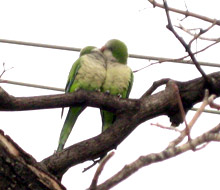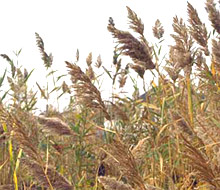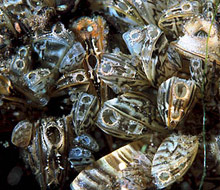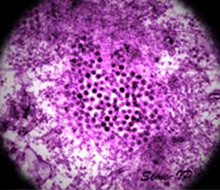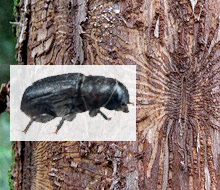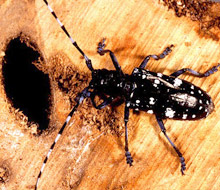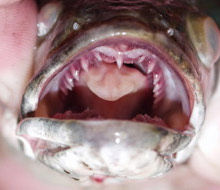|
QUAKER PARROT Myiopsitta monachus Also known as: Quaker Parakeet, Monk Parakeet Native home: Argentina Came to U.S.: Through Kennedy airport Threat: Utility companies say the birds' huge nests can threaten electricity transmission and even lead to blackouts. Government action: In New York, Con Ed has tried to dismantle nests and has discussed building platforms to entice the birds away from power lines. Other states, though, have adopted more draconian measures. |
|
COMMON REED Phragmites australis Native home: North America How it got here: The opportunistic reed has spread everywhere. While degradation of wetlands gets much of the blame, some scientists believe a hardier strain of the plant, native to Europe, may be adding to the problem. Threat: Crowds out other plants, depriving birds of plants needed for feeeding and nesting. Government action: The city has a plan to reduce some nitrogen discharges into marshes. Many environmentalists believe the city must adopt other measures to protect its wetlands from phragmites and other threats. |
|
ZEBRA MUSSEL Dreissena polymorpha Native home: Russia and European waterways How it got here: Commercial fishing boats and cargo ships transfer foreign species like the zebra mussel to new waters by dumping contaminated ballast water. Threat: In addition to making some native species nearly extinct, zebra mussels colonies can be so dense that they clog intake pipes at water and power plants. They have also contaminated the water at treatment facilities. Some argue, though, they aren't all bad, because they consume bacteria and decrease water contamination. Government action: As of Sept. 30, thanks to a lawsuit brought by New York and several other states against the Environmental Protection Agency, it will be illegal for ships to dump untreated ballast water. A bill regulating the cleanliness of ballast water is stalled in the U.S. Senate. |
|
WEST NILE VIRUS Virus of the family Flaviviridae Native home: First detected in Uganda in 1937, later found elsewhere in Africa, the Middle East and Europe. How it got here: Believed to have come in through LaGuardia airport, possibly in a mosquito or infected passenger. Threat: An encephalitis disease, it can make people very sick and can be fatal, particularly for the elderly or people with compromised immune systems. It has also killed many birds and can affect other animals as well. Government action: Use of insecticides to kill mosquitoes and their larvae. Public education campaigns to help people avoid mosquito bites and remove standing sources of water. |
|
BED BUG Cimex lectularius Native home: Europe How it got here: Brought by early colonists from Europe. Threat: They bite! Severe infestations can mean the loss of mattresses, furniture, clothing, etc., because the pests are so tricky to eradicate. Government action: The City Council is considering legislation that would require used mattresses be labeled and put in plastic bags when discarded. The city can fine landlords for bed bugs, and the state is considering a bill that requires the notification of parents when an infestation occurs at school. |
|
DUTCH ELM Ophiostoma novo-ulmi Native home: Asia How it got here: Came on imported timber in 1928. Threat: A fungus-caused and beetle-borne disease that can kill entire elm trees. It can also spread from one tree’s roots to another’s if two trees are close together. Government action: Thirty-five elms in Central Park have been infected, and 21 eradicated. The Central Park Conservancy has spent over $150,000 handling the problem, the site says. Containing the disease involves injecting fungicide in tree trunks, pruning affected branches and removing trees that are beyond salvation. |
|
ASIAN LONGHORN BEETLE Anoplophora glabripennis Native home: China How it got here: Believed to have come via shipping crates. Threat: The beetle, which was first found in the city in Greenpoint in 1996, can kill large swaths of hardwood, deciduous trees after laying eggs in their bark. They have been found in every borough, except the Bronx, and commonly attack maple, horsechestnut, elm, willow, birch, poplar, and ash trees. Government action: The city has established quarantined zones where infested trees are removed and chipped. These trees cannot be picked up with the rest of a resident's trash. |
|
NORTHERN SNAKEHEAD FISH Channa argus Also known as: Frankenfish Native home: China How it got here: unclear, but first discovered in Maryland, May 2002 Threat: According to a U.S. Fish and Wildlife Service news release, snakeheads are “voracious eating machines” that can ravage the natural balance of any freshwater environment. Government Action: The federal government banned snakeheads and their eggs in 2002. In New York, recent infestations have taken over the river system in Orange County’s Ridgebury Lake area. Residents are working with the state’s Department of Environmental Conservation to flush the river with Rotenone, a low-toxic pesticide, and clear the river of all fish in an effort to stop the snakehead’s proliferation. |
Back to Invasion New York
